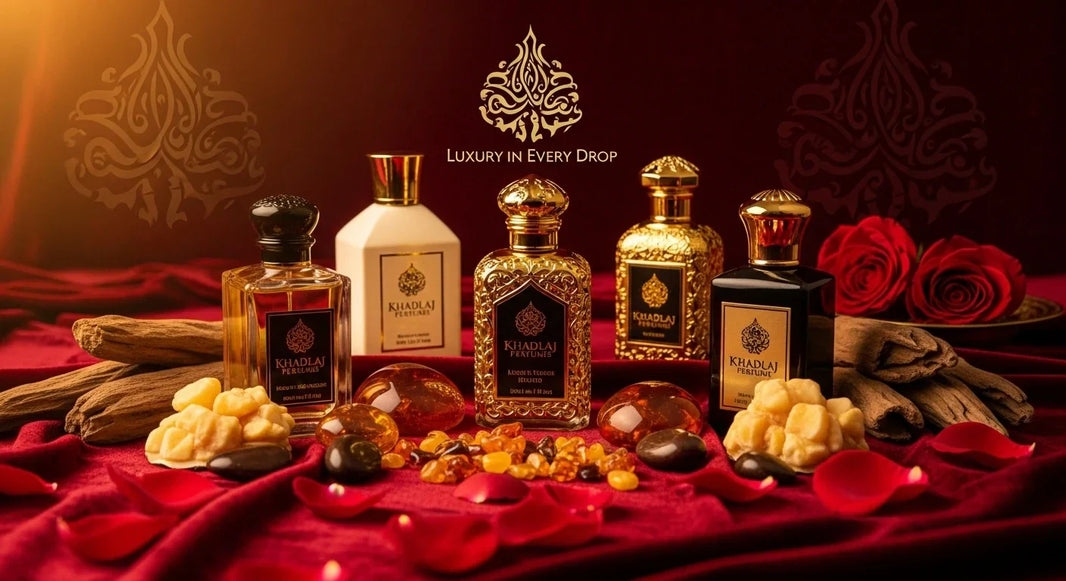When exploring the world of Arabic perfumes, you’ll quickly realize that understanding perfume notes is the secret to choosing the perfect scent. Whether you love deep, smoky oud or sweet floral blends, knowing how perfume notes work helps you recognize what makes a fragrance long-lasting, balanced, and truly captivating.
In this guide, we’ll break down the top perfume notes you should know before buying oud-based perfumes and how they influence your fragrance experience.

1. What Are Perfume Notes?
Perfume notes are the individual layers that make up a fragrance. They are categorized into top, middle, and base notes, each playing a distinct role in how a perfume smells over time.
-
Top Notes – The first impression of a perfume; they are light and evaporate quickly (e.g., citrus, bergamot, lavender).
-
Middle Notes (Heart Notes) – They appear once the top fades and form the core of the fragrance (e.g., rose, jasmine, amber).
-
Base Notes – These provide depth and longevity. Oud, musk, and sandalwood are common base notes in Arabic perfumes.
Understanding these layers helps you appreciate how a perfume unfolds and evolves on your skin.
2. Oud – The Star Base Note of Arabic Fragrances
When it comes to Arabic perfume notes, oud (agarwood) stands as the crown jewel. It’s derived from the resin of agarwood trees and is prized for its rich, woody, and slightly sweet aroma.
Oud adds depth and longevity, making it a key ingredient in high-end Middle Eastern and niche fragrances. Depending on the blend, oud can smell smoky, leathery, or even slightly sweet when mixed with amber or rose.
This base note is what makes many Arabic perfumes long-lasting and powerful, lingering for hours or even days.
3. Common Perfume Notes Found in Arabic Fragrances
Arabic perfumery often blends natural and luxurious ingredients to create deep, opulent scents. Here are some of the most loved notes:
-
Rose: Especially Taif or Damask rose, adds a soft floral heart to balance oud.
-
Amber: Warm and resinous, it enhances sweetness and sensuality.
-
Musk: A clean, comforting base note that boosts projection and depth.
-
Sandalwood: Creamy and woody, it smooths harsh notes and adds richness.
-
Patchouli: Earthy and grounding, often paired with spicy or woody bases.
-
Saffron: A luxurious top-to-heart note known for its warm, spicy aroma.
When blended with oud, these notes create a complex, memorable fragrance that defines authentic Arabic perfumery.
4. Perfume Notes Explained: How They Affect Longevity

If you’ve ever wondered why some perfumes fade fast while others last all day, it’s all about note composition.
-
Top notes provide instant freshness but disappear quickly.
-
Heart notes emerge next and last for several hours.
-
Base notes, especially oud and amber, anchor the fragrance and extend its wear time.
This is why oud perfumes often outlast traditional Western fragrances. Their heavy base composition allows them to cling to the skin and clothing longer.
5. How to Choose an Oud Perfume Based on Notes
When buying an Arabic perfume, check the note pyramid listed on the bottle or product page. It tells you how the scent will develop.
-
For a bold, masculine scent, look for oud mixed with leather, amber, or musk.
-
For a soft, feminine fragrance, choose oud blended with rose, vanilla, or jasmine.
-
For a unisex option, try oud paired with saffron, sandalwood, or patchouli.
Understanding the note harmony helps you pick a perfume that fits your style and the occasion.
6. Related Reading on Arabic Fragrances
For more insights into Arabic perfumery, explore:
7. Final Thoughts
Understanding perfume notes is key to choosing a fragrance that resonates with you. Whether you prefer floral oud, amber musk, or spicy saffron blends, knowing the structure and role of each note ensures you select a scent that suits your taste and lasts beautifully.
If you’re ready to experience the depth of Arabic oud perfumes, explore the collection at Sara Sakina—where every scent tells a story of luxury, tradition, and timeless elegance.